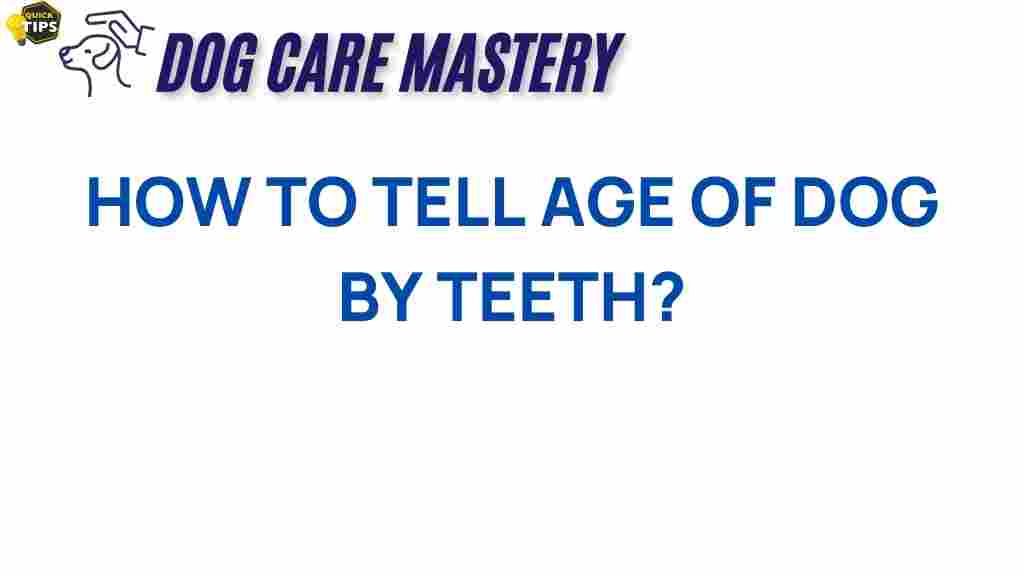Uncovering the Secrets: How to Tell Your Dog’s Age by Their Teeth
Understanding your dog’s age is crucial for providing the best care possible. While many pet owners rely on general guidelines, one of the most accurate ways to assess a dog’s age is by examining their teeth. In this article, we’ll delve into how you can determine your dog’s age using their dental health, providing you with all the insights you need to ensure your furry friend remains healthy and happy.
Understanding Dog Age Through Their Teeth
The condition and appearance of a dog’s teeth can reveal a lot about their age. Just like humans, dogs go through several stages of dental development throughout their lives. By observing the state of your dog’s teeth, you can estimate their age with reasonable accuracy. Below, we’ll break down what to look for at different life stages.
Puppy Teeth (0-6 Months)
During the first few months of life, puppies will develop a set of baby teeth. Here’s what to expect:
- Age 0-2 months: Puppies are born without teeth. Their first baby teeth usually erupt around three weeks of age.
- Age 3-4 months: By this age, puppies will have all 28 baby teeth. These teeth are sharp, white, and clean.
- Age 5-6 months: Puppies will start losing their baby teeth, which will be replaced by adult teeth.
Young Adult Teeth (6 Months – 2 Years)
Once your dog reaches six months, they will begin to grow their adult teeth. Here’s what to look for:
- Age 6-12 months: All adult teeth should be fully erupted by 6 months. They will be bright white and free of wear.
- Age 1-2 years: The teeth may begin to show slight wear but should still appear clean and white.
Adult Teeth (2-5 Years)
In this stage, your dog’s teeth will start to show signs of aging:
- Age 2-3 years: The teeth may show minimal wear with some tartar buildup.
- Age 4-5 years: You will notice more significant signs of wear and increased tartar accumulation.
Senior Teeth (5+ Years)
As dogs reach their senior years, dental health becomes more apparent:
- Age 6-7 years: Teeth may be worn down, and tartar buildup will be more pronounced. Some dogs may start to lose teeth.
- Age 8-10 years: You will likely see advanced wear and possible periodontal disease.
- Age 10+ years: Many dogs will have lost several teeth, with significant wear and decay.
Steps to Determine Your Dog’s Age by Their Teeth
Now that you understand the different stages of dental development, here’s a step-by-step guide to help you assess your dog’s age:
Step 1: Examine the Teeth
Start by carefully inspecting your dog’s teeth. You may need someone to help hold your dog still while you take a close look. Make sure to check:
- The presence of baby teeth
- The cleanliness and color of adult teeth
- Signs of wear or damage
- Tartar buildup and gum health
Step 2: Analyze the Findings
Once you have inspected your dog’s teeth, analyze your findings based on the age ranges outlined above. Keep in mind that some variations can occur due to factors like diet and oral hygiene.
Step 3: Consult a Veterinarian
If you’re uncertain about your dog’s age, it’s always a good idea to consult a veterinarian. They can provide a more accurate assessment based on dental health and overall condition. Regular dental check-ups are also crucial for maintaining your dog’s health.
Troubleshooting Common Issues
Sometimes, determining your dog’s age by their teeth can lead to confusion or uncertainty. Here are some common issues and how to troubleshoot them:
Problem: Excessive Tartar Buildup
If your dog has excessive tartar buildup, it may obscure the assessment of their age. Here’s what to do:
- Schedule a dental cleaning with your veterinarian.
- Implement a regular dental care routine, including brushing your dog’s teeth.
- Provide dental chews to help reduce tartar buildup.
Problem: Missing Teeth
If your dog is missing teeth, it can complicate the assessment of their age. Here’s how to address this:
- Older dogs may lose teeth due to periodontal disease. Consult your vet for treatment options.
- Consider other age indicators, such as overall activity level and health status.
Problem: Overlooking Other Age Indicators
Remember that teeth are just one indicator of age. If you’re having difficulty determining your dog’s age, consider:
- Physical condition (e.g., weight, mobility)
- Behavioral changes (e.g., energy levels, temperament)
- Health history (e.g., medical records, previous vet visits)
Conclusion
Determining your dog’s age through their teeth can provide valuable insights into their health and help you tailor their care accordingly. While examining teeth can give you a good estimate of your dog’s age, it’s essential to consider other factors such as overall health and behavior. Regular veterinary check-ups are crucial for maintaining your dog’s dental and overall health. For more detailed information on canine dental care, check out this comprehensive guide.
By understanding how to assess your dog’s age through their teeth, you can provide better care and ensure they live a long, healthy life. Remember, a healthy mouth contributes to a happy dog!
This article is in the category Health and created by dogcaremastery Team
